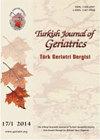评估老年患者脊柱麻醉前超声检查椎体解剖的作用:一项前瞻性随机试验
IF 0.3
4区 医学
Q4 GERIATRICS & GERONTOLOGY
Turkish Journal of Geriatrics-Turk Geriatri Dergisi
Pub Date : 2023-03-01
DOI:10.29400/tjgeri.2023.333
引用次数: 0
摘要
导言:本研究评估了术前超声检查脊髓轴解剖的重要性,以确保有效的脊髓麻醉给药,由于老年患者的生理和病理条件,这在技术上具有挑战性。材料与方法:入选美国麻醉医师学会体格分类为I-III级的脊柱麻醉下择期手术的老年患者。将患者分为解剖标志引导组和超声辅助组。记录脊髓阻滞应用次数、尝试次数和针头重定向次数。结果:在所研究的患者中,解剖标志引导组29例,超声辅助组30例。超声辅助组(74.6±7.41岁)与解剖标志引导组(75.6±7.52岁)患者的平均年龄差异无统计学意义。解剖标志引导组辅助手术时间和总手术时间均显著短于超声辅助组(p<0.001和p<0.05);超声辅助组脊柱穿刺次数、试验次数和针重定向均明显低于解剖地标引导组(p<0.05)。结论:老年患者腰麻术前超声检查可提高第一次穿刺成功率,减少穿刺次数和穿刺针重定向。关键词:老年病学;脊髓麻醉;超声本文章由计算机程序翻译,如有差异,请以英文原文为准。
Evaluating the Role of Vertebral Anatomy Examination by Ultrasonography Before Administering Spinal Anesthesia in Geriatric Patients: A Prospective Randomized Trial
Introduction: This study evaluated the importance of examining neuraxial anatomy by preprocedural ultrasonography to ensure effective spinal anesthesia administration, which can be technically challenging in geriatric patients owing to their physiological and pathological conditions. Materials and Methods: Geriatric patients with an American Society of Anesthesiologists’ physical classification of I–III undergoing elective surgery under spinal anesthesia were included. The patients were divided into two groups: the anatomical landmark-guided group and the ultrasound-assisted group. Spinal block application times, number of attempts and number of needle redirections were recorded. Results: Among the studied patients, 29 and 30 patients were included in the anatomical landmark-guided group and the ultrasound-assisted group groups, respectively. There was no significant difference in the mean age of the patients in the ultrasound-assisted group (74.6 ± 7.41 years) and the anatomical landmark-guided group (75.6 ± 7.52 years). Assisted procedure time and total operative time were significantly shorter in the anatomical landmark-guided group than in the ultrasound-assisted group (p<0.001 and p<0.05, respectively); however, spinal application times and number of trials and needle redirections were significantly lower in the ultrasound-assisted group than in the anatomical landmark-guided group (p<0.05 and p <0.05, respectively). Conclusion: Preprocedural ultrasonography before spinal anesthesia administration increases the first-attempt success rate and decreases the number of attempts and needle redirections in geriatric patients. Keywords: Geriatrics; Anesthesia, Spinal; Ultrasonography
求助全文
通过发布文献求助,成功后即可免费获取论文全文。
去求助
来源期刊

Turkish Journal of Geriatrics-Turk Geriatri Dergisi
GERIATRICS & GERONTOLOGY-
CiteScore
0.60
自引率
0.00%
发文量
46
审稿时长
6-12 weeks
期刊介绍:
Turkish Journal of Geriatrics is a peer-reviewed journal. Official language of the journal is English. Turkish Journal of Geriatrics invites submission of Original Articles based on clinical and laboratory studies. Review Articles are published only after the invitation from the Editorial Board.
 求助内容:
求助内容: 应助结果提醒方式:
应助结果提醒方式:


